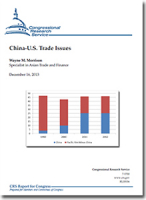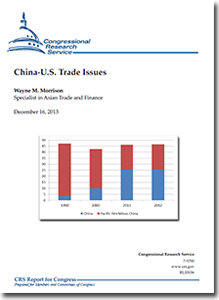China-U.S. Trade Issues
China’s economic growth and trade liberalization, including comprehensive trade commitments made upon entering the World Trade Organization (WTO) in 2001, have led to a sharp expansion in U.S.-China commercial ties.
U.S.-China economic ties have expanded substantially over the past three decades. Total U.S.- China trade rose from $5 billion in 1981 to $536 billion in 2012, and is projected to reach $558 billion in 2013.
China is currently the United States’ second-largest trading partner, its third largest export market, and its biggest source of imports. China is estimated to be a $300 billion
market for U.S. firms (based on U.S. exports to China and sales by U.S.-invested firms in China).
Many U.S. firms view participation in China’s market as critical to staying globally competitive. General Motors (GM), for example, which has invested heavily in China, sold more cars in China than in the United States from 2010 to 2012. In addition, U.S. imports of low-cost goods from China greatly benefit U.S. consumers, and U.S. firms that use China as the final point of assembly for their products, or use Chinese-made inputs for production in the United States, are able to lower costs. China is the largest foreign holder of U.S. Treasury securities ($1.3 trillion as of October 2013). China’s purchases of U.S. government debt help keep U.S. interest rates low.
Despite growing commercial ties, the bilateral economic relationship has become increasingly complex and often fraught with tension. From the U.S. perspective, many trade tensions stem from China’s incomplete transition to a free market economy.
While China has significantly liberalized it’s economic and trade regimes over the past three decades, it continues to maintain, (or has recently imposed) a number state-directed policies that appear to distort trade and investment flows
What’s Related

Favorites





